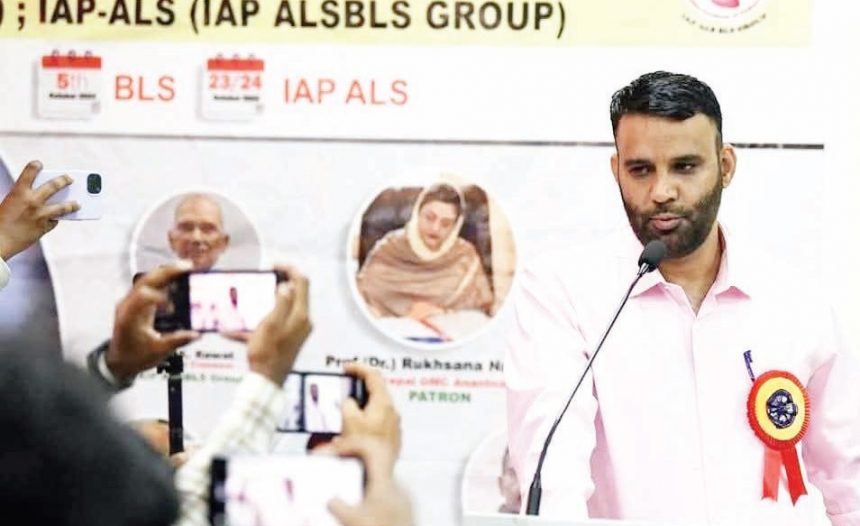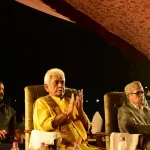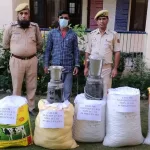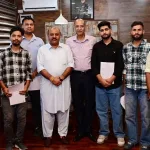Dr. Showkat Hussain Tali, Associate Professor and Head of the Department of Pediatrics at Government Medical College Anantnag, says nearly half of childhood deaths occur within the first 28 days, a critical window when newborns are most vulnerable to conditions like blindness, deafness or cerebral palsy. In an interview with Rising Kashmir reporter Younus Rashid, Dr. Tali said there is an urgent need to improve neonatal care in rural Kashmir and added that every newborn, regardless of where they are born, deserves a fair chance at life.
What are the common challenges in providing neonatological care in rural setups, and how can a dedicated setup help?
Working in rural areas breaks your heart sometimes. There is barely any specialized care, the equipment is either old or missing, and we are always short on trained hands. You are fighting to save newborns with so little. A proper neonatal unit at district and sub-district level health care facilities, with basic and advanced neonatal care facilities and equipment and trained staff, would change everything. It would mean we could treat babies right there, no long trips to distant cities, and we could train local folks to step up, giving every newborn a real shot.
How does the lack of specialized neonatal care impact infant mortality and rural communities?
Neonatal mortality rate (babies dying during the first 28 days of life) contributes 47 percent to under-five mortality rate, which is simply huge.
Without neonatal care, too many babies do not make it, and it leaves families shattered. I have seen parents’ faces when they lose a child. It is a pain that lingers. Those who survive often face lifelong health issues, dragging communities deeper into poverty and inequality. If we had district and sub-district-level fully functional neonatal units with the right gear, we could save so many lives and give rural families hope for a healthier future. Just imagine when you save a baby from death and damage during the first 28 days of life, you give to the society, on an average, more than 70 life years per person. That is never true for any other population.
What role can neonatologists play in reducing neonatal morbidity and mortality in rural areas?
As neonatologists, we are not just doctors. We are teachers and fighters. We do our best to save babies, train local nursing staff and doctors, and spread awareness about newborn care. But we need proper neonatal setups to make a real dent. No more relying on bare hands. We also push for better policies to get equipment and resources where they are needed so no baby’s life depends on their zip code.
How can neonatology care be integrated into rural healthcare systems?
As far as neonatal care is concerned, there is already a well-conceived framework in place under the National Health Mission. It consists of newborn care corners, newborn stabilization units and special newborn care units. They need to be made fully and optimally functional. As far as advanced neonatal care is concerned, it starts with building advanced neonatal care units at district hospitals and places with proper space, equipment and trained manpower. Nursing and ancillary staff make the backbone for any level of neonatal care and must be addressed on priority. To begin with, you need not have highly skilled nursing staff for neonatal care, as any nursing officer can be trained for the same within a very short time period. Even locally hired staff can be trained for the same and telemedicine may be used to connect with specialists. Let us not forget that it is not just about equipment. It is about working with communities and getting policymakers to back us up. That is how we make care reach every newborn, no matter how remote.
How can the shortage of skilled healthcare workers in rural neonatal care be addressed?
We can train people all day, but not without a proper setup. It is like teaching someone to cook without a kitchen. If district-level hospitals and new Government Medical Colleges have fully functional neonatal units with the right equipment, we could run training programs, mentor local staff, and offer incentives to bring doctors and nurses to rural areas. Tele-training and remote support help, but it is the infrastructure that makes the difference. Otherwise, we are just patching up gaps.
How can technology be leveraged to support neonatal care in rural setups?
Technology is a lifesaver. Telemedicine lets us consult with specialists miles away, remote monitors keep an eye on fragile babies, and online training keeps our skills sharp. But let us be real. None of this works without a solid and advanced neonatal care unit. You need the machines to back up the technology or it is just a fancy idea that cannot save lives.
What are the key components of a strong neonatology setup in rural areas?
It is simple but tough. You need modern equipment such as open care systems, incubators, ventilators, monitors, infusion devices, and so on in a dedicated neonatal unit at every district-level health facility or to begin with, at every newly created medical college pediatric hospital. Add trained staff who keep learning, a community that trusts you, and policies that keep the lights on. Without that foundation, we are just hoping for miracles. And miracles do work but happen rarely.
How can healthcare providers promote community awareness and education to improve neonatal outcomes?
We have got to meet people where they are, talking to mothers and families in their language, using simple explanations, maybe even drawings, to share why newborn care matters. We need to conduct outreach programmes in villages and work with local leaders to spread the word. But it is so much stronger when we have got a neonatal unit nearby to back up our words with real care.








